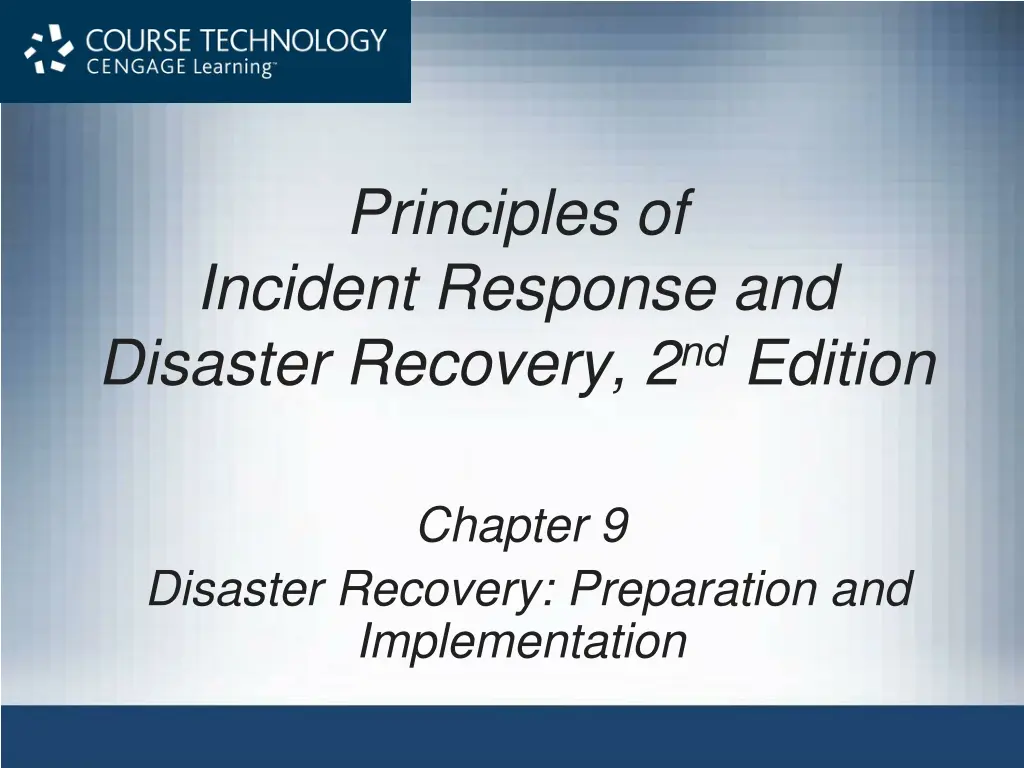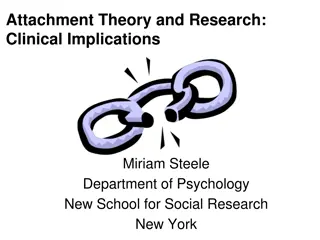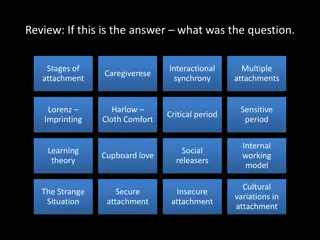
Disaster Recovery and Incident Response Principles
Learn about disaster recovery and incident response principles, including disaster classifications, team formation, key functions of a disaster plan, and NIST approach to technical contingency planning. Understand the importance of disaster recovery planning and how to establish operations post-disaster effectively.
Download Presentation

Please find below an Image/Link to download the presentation.
The content on the website is provided AS IS for your information and personal use only. It may not be sold, licensed, or shared on other websites without obtaining consent from the author. If you encounter any issues during the download, it is possible that the publisher has removed the file from their server.
You are allowed to download the files provided on this website for personal or commercial use, subject to the condition that they are used lawfully. All files are the property of their respective owners.
The content on the website is provided AS IS for your information and personal use only. It may not be sold, licensed, or shared on other websites without obtaining consent from the author.
E N D
Presentation Transcript
Principles of Incident Response and Disaster Recovery, 2ndEdition Chapter 9 Disaster Recovery: Preparation and Implementation
Objectives Describe the ways to classify disasters, by both speed of onset and source Explain who should form the membership of the disaster recovery team List the key functions of the disaster plan Explain the key concepts included in the NIST approach to technical contingency planning Principles of Incident Response and Disaster Recovery, 2nd Edition 2
Objectives (contd.) List the elements of a sample disaster recovery plan Describe the need for providing wide access to the planning documents while securing the sensitive content of the disaster recovery plans Principles of Incident Response and Disaster Recovery, 2nd Edition 3
Introduction Disaster recovery planning (DRP) The preparation for and recovery from a disaster, whether natural or man-made The continuity planning management team (CPMT) Forms the DR team, then assists in the development of the DR plan Key role of a DR plan Defining how to reestablish operations at the location where the organization is usually located Principles of Incident Response and Disaster Recovery, 2nd Edition 4
Disaster Classifications Man-made disasters include: Acts of terrorism, acts of war, and those acts of man that begin as incidents and escalate into disasters Rapid-onset disasters Those that occur suddenly, with little warning, taking the lives of people and destroying the means of production Slow-onset disasters Occur over time and slowly deteriorate the organization s capacity to withstand their effects Principles of Incident Response and Disaster Recovery, 2nd Edition 5
Principles of Incident Response and Disaster Recovery, 2nd Edition 6
Principles of Incident Response and Disaster Recovery, 2nd Edition 7
Forming the Disaster Recovery Team The CPMT assembles a DR team DR team Responsible for planning for DR Leads the DR process when the disaster is declared Key considerations when developing the DR team Its organization The planning needed to identify essential documentation and equipment Training and rehearsal Principles of Incident Response and Disaster Recovery, 2nd Edition 8
Organization of the DR Team The primary DR team includes representatives from: Senior management Corporate support Facilities Fire and safety Maintenance staff IT technical staff IT managers InfoSec technicians InfoSec managers Principles of Incident Response and Disaster Recovery, 2nd Edition 9
Organization of the DR Team (contd.) Disaster management team Responsible for all the planning and coordination activities Communications team Serves as the voice of the management, providing feedback to anyone desiring additional information Computer recovery (hardware) team Works closely with the hardware and applications teams to reestablish systems functions during recovery Principles of Incident Response and Disaster Recovery, 2nd Edition 10
Organization of the DR Team (contd.) Network recovery team Works to determine the extent of damage to the network wiring and hardware Storage recovery team Works with the other teams to recover information and reestablish operations Applications recovery team Recovers applications and reintegrates users back into the systems Principles of Incident Response and Disaster Recovery, 2nd Edition 11
Organization of the DR Team (contd.) Vendor contact team Works with suppliers and vendors to replace damaged or destroyed materials, equipment, or services Damage assessment and salvage team Provides initial assessments of the extent of damage to materials, inventory, equipment, and systems on- site Business interface team Works with the remainder of the organization to assist in the recovery of nontechnology functions Principles of Incident Response and Disaster Recovery, 2nd Edition 12
Organization of the DR Team (contd.) Logistics team Consists of the individuals responsible for providing any needed supplies, space, materials, food, services, or facilities at the primary site Other teams as needed Focus on the reestablishment of key business functions as determined by the BIA Principles of Incident Response and Disaster Recovery, 2nd Edition 13
Special Documentation and Equipment Necessary equipment may include: Data recovery software Redundant hardware and components to rebuild damaged systems Copies of building blueprints to direct recovery efforts Key phone numbers Alert roster first contacts Fire and water damage specialists Emergency supplies Principles of Incident Response and Disaster Recovery, 2nd Edition 14
Disaster Recovery Planning Functions The seven-step DRP process recommended by NIST Develop the DR planning policy statement Review the business impact analysis (BIA) Identify preventive controls Create DR contingency strategies Develop the DR plan Ensure DR plan testing, training, and exercises Ensure DR plan maintenance Principles of Incident Response and Disaster Recovery, 2nd Edition 15
Develop the DR Planning Policy Statement The DR policy contains the following key elements Purpose Scope Roles and responsibilities Resource requirements Training requirements Exercise and testing schedules Plan maintenance schedule Special considerations Principles of Incident Response and Disaster Recovery, 2nd Edition 16
Review the Business Impact Analysis DR-centric review of the BIA Only requires a review of the BIA that was developed by the CPMT Ensures compatibility with DR-specific plans and operations Principles of Incident Response and Disaster Recovery, 2nd Edition 17
Identify Preventive Controls This is performed as part of the ongoing information security posture Effective preventive controls Implemented to safeguard online and physical information storage The team should Ensure that sufficient and secure off-site data storage is implemented, tested, and maintained Principles of Incident Response and Disaster Recovery, 2nd Edition 18
Develop Recovery Strategies The after the action actions must be thoroughly developed and tested DR strategies Must include the steps necessary to fully restore the organization to its operational status One key aspect of the DR strategy The enlistment and retention of qualified general contractors Principles of Incident Response and Disaster Recovery, 2nd Edition 19
Develop the DR Plan Document Disaster scenario A description of the disasters that may befall an organization, along with information on their probability of occurrence A brief description of the organization s actions to prepare for that disaster The best case, worst case, and most likely case outcomes of the disaster Principles of Incident Response and Disaster Recovery, 2nd Edition 20
Develop the DR Plan Document (cont d.) During the disaster The planners develop and document the procedures that must be performed during the disaster, if any After the disaster Once procedures for reacting to a disaster are drafted, the planners develop and document the procedures that must be performed immediately Before the disaster Planners draft a third set of procedures listing those tasks that must be performed to prepare for the disaster Principles of Incident Response and Disaster Recovery, 2nd Edition 21
Develop the DR Plan Document (cont d.) Planning for actions taken during the disaster DR usually begins with a trigger Trigger: the point at which a management decision to react is made Best way to plan for actions during a disaster is to develop disaster end cases Determine what must be done to react to the disaster scenario Once all signs of the disaster have ceased, the actions during phase is complete Principles of Incident Response and Disaster Recovery, 2nd Edition 22
Develop the DR Plan Document (cont d.) Planning for actions taken after the disaster During this phase, lost or damaged data is restored, systems are scrubbed of infection, and everything is restored to its previous state Follow-on incidents are highly probable when infected machines are brought back online Forensic analysis The process of systematically examining information assets for evidentiary material that can provide insight into how an incident transpired The DR team must conduct an AAR Principles of Incident Response and Disaster Recovery, 2nd Edition 23
Develop the DR Plan Document (cont d.) Planning for actions taken before the disaster Before actions include Preventive measures to manage the risks associated with a particular attack The actions taken to enhance the preparedness of the IR team For DR and IR planning When selecting an off-site storage location for data backups or stored equipment, extra care should be taken to minimize the risk at that storage location Principles of Incident Response and Disaster Recovery, 2nd Edition 24
Plan Testing, Training, and Exercises Testing the DR plan is an ongoing activity Recent survey from Symantec At least 82 percent of organizations test their DR plans either once a year or more frequently Once all the individual components of the DR plan have been drafted and tested The final DR plan can be created, similar in format and appearance to the IR plan Principles of Incident Response and Disaster Recovery, 2nd Edition 25
Plan Maintenance The plan Should be a dynamic document that is updated regularly to remain current with system enhancements If the organization changes its size, location, or business focus The DR management team should begin anew with the CP plan, and it should also reexamine the BIA Principles of Incident Response and Disaster Recovery, 2nd Edition 26
Information Technology Contingency Planning Considerations Commonly found systems in production or development settings Client/server systems Data communications systems Mainframe systems Principles of Incident Response and Disaster Recovery, 2nd Edition 27
Client/Server Systems The client level includes: Desktop, laptop, or netbook systems, tablets, as well as specialty devices, such as smartphones Client/server systems contingency strategies must include Backup media stored off-site or at an alternate site Use of standardized hardware, software, and peripherals to enable backup and recovery Documentation of all supported system configurations, with local copies of key vendor information Principles of Incident Response and Disaster Recovery, 2nd Edition 28
Client/Server Systems (contd.) Client/server systems contingency strategies must include (cont d.) Coordination with security policies and system security controls used in the organization Reliance on the systems priority and key data needs as documented in the BIA Processes that aggressively limit the placement of data on client systems, with any local data kept for the minimum possible time Principles of Incident Response and Disaster Recovery, 2nd Edition 29
Client/Server Systems (contd.) Client/server systems contingency strategies must include (cont d.) Sound procedures established to back up and periodically test restoration of local data Automation of backup processes and proactive validation of the automated backup by repeatable processes Coordination of all contingency solutions with the cyber IR plans and team operations Principles of Incident Response and Disaster Recovery, 2nd Edition 30
Client/Server Systems (contd.) Client/server systems contingency solutions Encryption tools Widely used to ensure the confidentiality and integrity of communication between clients and servers Recovery will rely on complete planning, training, and rehearsals Principles of Incident Response and Disaster Recovery, 2nd Edition 31
Data Communications Systems Local area networks (LANs) Used for an office or small campus, with segment distances measured in tens of meters Each connection point is considered a node Each system (client or server) is considered a host Wide area networks (WANs) A collection of nodes in which the segments are geographically dispersed Principles of Incident Response and Disaster Recovery, 2nd Edition 32
Data Communications Systems (cont d.) Data communications contingency strategies rely on Complete and current documentation of the telecommunications networks Coordination with service-providing vendors, Coordination with organizational security policies and controls Implementation of redundancy in critical components to remove single points of failure Principles of Incident Response and Disaster Recovery, 2nd Edition 33
Data Communications Systems (cont d.) Data communications contingency strategies rely on (cont d) Identification of remaining single points of failure as ongoing efforts to remove them progress Monitoring of the networks to measure uptime and minimize downtime by providing early detection of failures Integration of remote access and wireless LAN technology Principles of Incident Response and Disaster Recovery, 2nd Edition 34
Mainframe Systems Rely on centralization of key capabilities When client/server systems interact with mainframes The client is often programmed to emulate much simpler data terminals The data processing and data storage functions are completed by the mainframe, with the client performing only data display functions Principles of Incident Response and Disaster Recovery, 2nd Edition 35
Mainframe Systems (contd.) Mainframe contingency strategies require: Storage of backup media off-site Documentation of all systems configurations to include details unique to specific vendor implementations Coordination with network security policy and system security controls Redundant system components Coordination of all contingency solutions with the IR plans and team operations Sequencing of replacement networking capabilities Principles of Incident Response and Disaster Recovery, 2nd Edition 36
Principles of Incident Response and Disaster Recovery, 2nd Edition 37
Sample Disaster Recovery Plans Principles of Incident Response and Disaster Recovery, 2nd Edition 38
Sample Disaster Recovery Plans (cont d.) Principles of Incident Response and Disaster Recovery, 2nd Edition 39
The Business Resumption Plan DR and BC plans Many organizations prepare them at the same time because they are related Some combine them into a single planning document (business resumption plan) to reduce the effort and cost Business resumption plan (BR plan) Must support the immediate reestablishment of operations at an alternate site and eventual reestablishment of operations at the primary site Principles of Incident Response and Disaster Recovery, 2nd Edition 40
The DR Plan The planning process for the DR plan Should be tied to, but distinct from, that for the IR plan When the plan is completed It needs to be stored and kept available in as many locations and formats as possible Principles of Incident Response and Disaster Recovery, 2nd Edition 41
Summary DR planning is the preparation for and recovery from a disaster A DR plan can classify disasters as either natural or man-made The CPMT assembles the DR team The DR team consists of representatives from every major organizational unit All members of the DR team should have multiple copies of the DR (and BC) plan Principles of Incident Response and Disaster Recovery, 2nd Edition 42
Summary (contd.) The first step in the effort to craft any contingency plan (CP) is the development of enabling policy or policies The NIST planning process adapted for DR planning The DR team begins with the development of the DR policy Training in the use of the DR plan can be used to test its validity and effectiveness Principles of Incident Response and Disaster Recovery, 2nd Edition 43






















